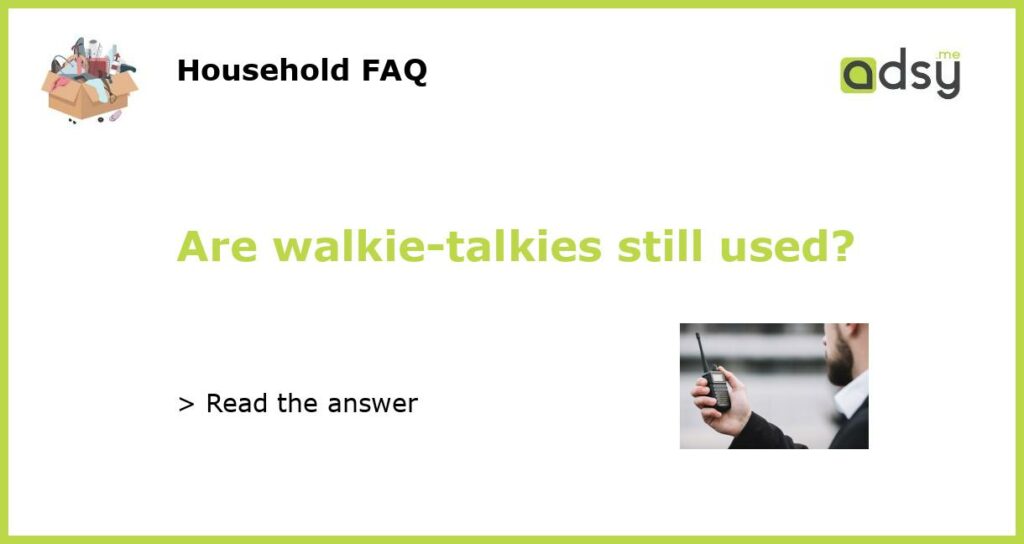Yes, walkie-talkies are still widely used in various industries and activities.
Walkie-talkies, also known as two-way radios, have been a reliable means of communication for decades. While technological advancements have introduced more advanced communication devices like smartphones, walkie-talkies continue to serve as an essential tool in many industries.
Who uses walkie-talkies?
Walkie-talkies are commonly used in industries such as construction, security, logistics, hospitality, and event management. In construction sites, walkie-talkies are used to maintain real-time communication between different teams to ensure seamless coordination and safety. Security personnel rely on walkie-talkies for quick and efficient communication during patrols or emergency situations.
In logistics, walkie-talkies are essential for coordinating the movement of goods and vehicles, ensuring timely deliveries. In the hospitality industry, walkie-talkies are used by staff to communicate with each other, enhancing customer service and facilitating efficient operations. Event managers use walkie-talkies to communicate with their teams during large-scale events, facilitating smooth operations and ensuring everyone is on the same page.
Advantages of using walkie-talkies
One of the primary advantages of using walkie-talkies is their reliability in areas with limited or no cellular network coverage. Unlike smartphones, which rely on cellular towers, walkie-talkies use radio frequencies, making them suitable for use in remote locations or during emergencies when cellular connectivity may not be available.
Another advantage is their durability. Walkie-talkies are designed to withstand tough environments and are often built to military-grade standards. They can handle drops, dust, water, and extreme temperatures, making them ideal for use in industries such as construction and outdoor activities.
Walkie-talkies also provide instant communication, allowing users to relay messages immediately without the need for dialing or waiting for a call to connect. This can be especially important in urgent or time-sensitive situations where quick response times are crucial. The push-to-talk feature of walkie-talkies allows for immediate communication, similar to a real-time conversation.
Modern features of walkie-talkies
While the basic functionality of walkie-talkies remains the same, modern models come with additional features that enhance their usability. Some walkie-talkies include built-in GPS functionality, allowing users to track the location of team members or assets. This can be particularly useful in industries such as logistics or search and rescue operations.
Bluetooth connectivity is another modern feature found in some walkie-talkies. This allows users to connect their walkie-talkies to other devices, such as wireless earpieces or mobile phones, further enhancing convenience and versatility.
Walkie-talkies in recreational activities
While walkie-talkies are commonly associated with professional use, they are also popular in recreational activities such as camping, hiking, and outdoor adventures. Walkie-talkies are an excellent way to stay connected with friends or family members in remote locations where cellular coverage may be limited.
Walkie-talkies are often more practical than mobile phones in outdoor settings as they have longer battery life and are more durable. They provide a reliable means of communication, allowing group members to stay in touch or coordinate their activities, enhancing safety and convenience during outdoor adventures.
The future of walkie-talkies
While smartphones have become ubiquitous in our modern society, walkie-talkies continue to serve a specific purpose and are likely to continue being used in various industries and activities. The advancements in technology have allowed walkie-talkies to evolve, incorporating features that make them even more versatile and reliable.
In conclusion, walkie-talkies are still widely used in various industries and recreational activities. Their reliability, durability, and instant communication capabilities make them an essential tool for professionals who require efficient communication in remote locations or where cellular coverage is limited. With modern features such as GPS and Bluetooth connectivity, walkie-talkies continue to adapt to the changing needs of users. While smartphones may dominate personal communication, walkie-talkies offer distinct advantages in specific scenarios, ensuring their continued relevance.






